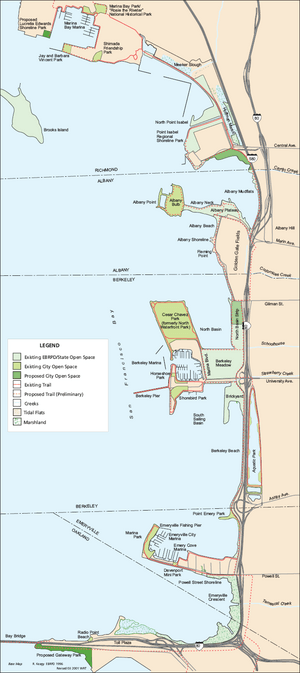McLaughlin Eastshore State Park facts for kids
Quick facts for kids McLaughlin Eastshore State Park |
|
|---|---|
| Location | San Francisco Bay Area |
| Area | 1854 acres |
| Operated by | East Bay Regional Park District |
McLaughlin Eastshore State Park is a special place along the San Francisco Bay shoreline. It's located in the East Bay area of California. This park stretches between the cities of Richmond, Albany, Berkeley, Emeryville, and Oakland.
The park is a mix of natural wetlands and restored areas. It also includes land that was once a landfill (a place where trash is buried). The park's shoreline is about 8.5 miles (13.7 km) long. Its total size is 1,854 acres (750 ha), which includes both land and areas covered by tides.
The park was first called Eastshore State Park. In October 2012, it was renamed to honor Sylvia McLaughlin. She was a very important person who helped create the park. She founded an environmental group called Save the Bay. Before 2013, the park was managed by both California State Parks and the East Bay Regional Park District (EBRPD). Now, EBRPD manages the park under a 30-year agreement.
Contents
How the Park Was Created
Protecting the Bay Shoreline
In the 1960s, people noticed that the East Shore of San Francisco Bay was changing fast. There was a lot of new building and trash piling up. A large piece of land, about 72 acres (29 ha), became a big concern. This land was between Emeryville and Richmond. Developers wanted to build shopping centers and tall hotels there.
Sylvia McLaughlin's Fight for the Bay
Sylvia McLaughlin, a local person, was very worried about the bay. She gathered friends and started a group called Save San Francisco Bay Association. This group later became Save the Bay. They quickly started working to protect the shoreline.
At first, they wanted to raise money for a small park in Berkeley. But soon, they realized that stopping people from dumping trash into the bay was more urgent. In 1969, a state agency called the Bay Conservation and Development Commission (BCDC) became permanent. This group supported the idea of the state park system buying the land.
However, the California State Parks agency wasn't very interested. They didn't have much experience with city land. The East Bay Regional Park District (EBRPD) thought the state should lead the project. Meanwhile, the land owners, Atchison, Topeka and Santa Fe Railway (Santa Fe), believed their property would be worth more if they kept it.
Battles Over Development
Santa Fe faced a setback in 1972. The city of Berkeley voted against a plan to build a shopping center on the landfill. Santa Fe sued the city but lost in 1980. The Supreme Court of California said no to the building plan.
Another setback happened when the BCDC stopped Santa Fe's plan to build tall buildings over wetlands in Emeryville. Locals called this project "stilt city." After the Supreme Court ruling, the California State Park and Recreation Commission added the shoreline park to its list of important projects. They recommended creating an East Bay shoreline park. But progress stopped in 1983 when George Deukmejian became Governor.
Buying the Land for the Park
Santa Fe kept trying to build big projects along the shorelines. Their real estate company, Catellus Development Company, lost more court cases. Finally, in 1990, they gave up.
In 1998, California's money situation improved. Voters approved two important plans. These plans raised $40 million to buy land for the new Eastshore park. Also, a law in the California State Legislature allowed EBRPD to use state money to buy and manage the park.
By 1992, EBRPD had bought parts of the land. These included the Emeryville Crescent, Albany Mudflats, and part of Hoffman Marsh. By 1998, they also bought the Berkeley Meadow, Brickyard Cove, and the North Basin Strip. Catellus wanted $80 million for the former Santa Fe land. But EBRPD said they might use eminent domain (the government's right to take private property for public use). So, Catellus agreed to sell the land for $27.5 million.
Different Ideas for Park Use
Even after buying the land, there were disagreements about how to use it. The City of Berkeley was supposed to give its old landfill for the park. But they held it back, worried that fun activities would be too limited. This land is now Cesar Chavez Park.
Albany's old landfill, the Albany Bulb, was also debated. Some people wanted it to be only for nature, with no visitors. Others wanted people to keep using it for fun. It was set aside to become part of the state park later, but this has not happened yet.
North Point Isabel was a toxic landfill that was cleaned up in the 1980s. It was popular for recreation, including walking dogs without leashes. Some groups wanted to limit activities there and require dogs to be on leashes. However, many people supported keeping it open for off-leash dog walking. So, park planners allowed off-leash recreation to continue there.
Park Improvements in 2016
In March 2016, EBRPD announced plans for $2 million in improvements. They planned to extend the San Francisco Bay Trail. They also wanted to remove trash, bad soil, and unwanted plants from parts of the park.
A large dirt pile, which had been an eyesore for over ten years, was also to be lowered. Its height was reduced by 15 feet (4.6 m). The dirt was used to create small hills. These hills would act as a barrier between the park and the nearby freeway. The hills were planted with native grasses. This helps create better homes for shorebirds and other wildlife.
Another project was to finish the restoration of Albany Beach. This included making the beach and dunes better. It also added a place for non-motorized boats, a restroom, parking, and about a mile of the Bay Trail.
Nearby Parks


